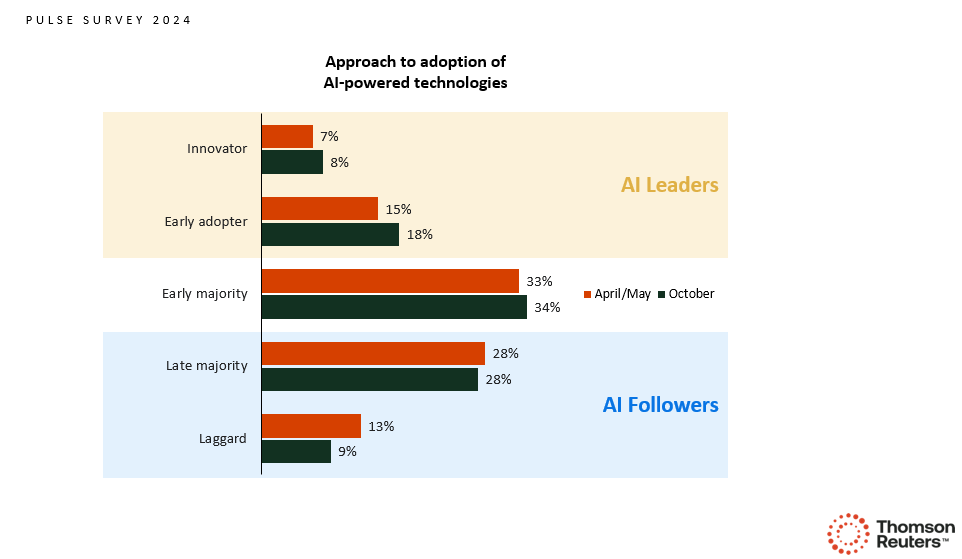The AI adoption curve within professional organizations is beginning to shift towards more early adoption, reveals new data from the “Future of Professionals” report — and those early adopters expect benefits to their organizations’ bottom line
As the business world approaches two years since generative artificial intelligence (GenAI) burst into the public marketplace, three things are clear. First, GenAI is being adopted at a rate quicker than any other recent technology for both personal and professional uses. Second, GenAI has staying power, as many organizations are including it in their long-term plans.
And the third, and perhaps most interesting for professional services, there appears to be growing bifurcation between those organizations that are embracing GenAI and those that are not. At this point, most organizations have at least had conversations around where GenAI would fit within their own organizations. For some, it’s seen as a force multiplier for business opportunities and operational efficiency, and a natural fit to future for growth. Others see GenAI as less than a core part of their business, and perhaps extraneous to the needs and goals of a professional services organization.
To measure this, the Thomson Reuters Institute decided to follow up the 2024 Future of Professionals Report, released in July, to ask few simple questions that expand on that one overarching point: How do those organizations that are embracing AI-powered technologies and those that are not differ on their view of the future? The research finds organizations that are embracing AI early, the AI early adopters, have professionals already realizing business value and career goals. Those organizations which have taken a wait-and-see view of AI, the AI followers, may be missing revenue opportunities and are risking employee dissatisfaction.
Leaders and followers
According to the research, the AI adoption curve in professional services firms and corporate departments is beginning to shift, with organizations increasingly striving to be ahead of the curve.
During the initial Future of Professionals research conducted between April and May 2024, 21% of respondents rated their organizations as an AI leader — an innovator or early adopter — when it came to AI. Today, that figure stands at 25% of respondents. Similarly, the portion of respondents who then called their organization a laggard or in the late majority (our AI followers) stood at 13%, but since that time has dropped to 9%.

To be sure, the AI adoption curve within professional services still largely mirrors a bell curve in which most organizations clearly want to be in the early majority. However, early indications are that organizations may be trending towards early adoption of AI-powered technologies faster than expected because of positive early returns.
In total, 70% of professional services respondents said that their team is already seeing the benefits of using AI-powered technologies for tasks such as research, drafting, document summarization, and automation. This total increases to 94% of respondents if you look at those respondents who categorized their organization as AI leaders.
Conversely, almost half (49%) of respondents said they believe moving more slowly than the market would have a negative (47%) or even catastrophic (2%) impact on their organization. This figure rises to 75% of respondents who are AI leaders — indicating that for organizations that have adopted AI early, there is little impetus to return to a pre-AI era.
“It’s an exciting space to watch develop. I think it will provide efficiencies and generate new approaches that will benefit the industry long-term,” one government attorney told researchers earlier this year. “I warn caution as it will take time before the full benefits are realized, and considerable human oversight will be required in the early stages. The long-term benefits will be great, though.”
Another corporate respondent took a more practical view, but one that speaks to the technology’s rapid adoption: “If we don’t use it, we will fall behind the industry standard,” they said. “But it has to be applied in a way that mitigates risk.”
A clear business impact
Perhaps just as notable, however, is the difference between how AI leaders and AI followers interpret the impact of technology both now and in the future. Those who said their organizations are AI leaders said they also believe adopting AI will have a tangible impact on their organization’s bottom line and its ability to attract and retain talent.
When asked whether AI drives revenue growth, respondents from AI leader and AI follower organizations saw a wide split. For respondents at AI leader organizations, for example, 70% said they believe AI is going to drive revenue growth for their organizations over the next 12 months. Indeed, AI and GenAI tools are already becoming a regular part of daily work for these professionals, indicating that those who have had their hands on the technology already are seeing its potential to result in positive business outcomes, even at this early stage.
The research finds organizations that are embracing AI early have professionals already realizing business value and career goals; and those organizations which have taken a wait-and-see view of AI may be missing revenue opportunities and are risking employee dissatisfaction.
At AI follower organizations, however, just 19% of respondents said they believe AI will drive revenue growth. This could show that their organizations are not yet successful in translating technology into revenue due to later adoption; or perhaps, it’s that they believe AI implementation has no effect on revenue. However, this latter reason would certainly contradict other studies of the business marketplace, such as a 2023 McKinsey report that showed that those businesses investing in AI were experiencing a revenue increase of between 3% and 15%.
And it’s not just revenue that has shown to be impacted, however, as many professionals said they believe that even their own career paths will be modified by their organization’s AI usage. More than two-thirds (68%) of respondents at AI leader organizations said they will definitely or almost definitely stay at their organization in the next 12 months; less than half (48%) of respondents at AI follower organizations said the same. Meanwhile, 17% of respondents at AI follower organizations said they will probably or definitely leave their job in the next year, while just 6% of respondents at AI leaders said the same.
One corporate legal attorney respondent who spoke to researchers earlier this year called AI investment a “win-win proposition” for both the organization and their own career. “Any time technology can be leveraged to make me more efficient for my company and in my practice, I think that will provide a net benefit to my career and the industry,” the corporate attorney said.
Another corporate tax manager explained that the time saved by investing in AI creates opportunities for higher value work. “I know that AI will be able to automate and simplify many tasks that are currently done manually by teammates,” the tax manager said. “I have played with AI on a personal level and know it has limitations, but [it] will be extremely helpful in freeing up time for value-added activities.”
Indeed, it’s a simple maxim, but one that’s reflected in the research: Professionals who feel positively about AI want to work at AI leader organizations. When looking just at the subset of respondents who were worried about moving too slowly on AI, for instance, those who are at AI leaders were likely to stay 71% of the time and planning to leave just 4% of the time. Those worried about moving slowly on AI but were working at AI follower organizations, however, were more likely to plan to leave (35%) within the next 12 months than to stay (33%).
And as GenAI adoption continues to ramp up at many professional services organizations, so too will the number of legal, tax & accounting, and risk & fraud professionals looking to integrate AI into their own work. Organizations that did not begin leveraging AI-enabled technologies on a more institutional basis may risk being left behind by these more forward-looking organizations and their more AI-savvy professionals.
You can download a full copy of the Thomson Reuters Future of Professionals report here.







